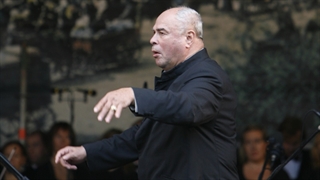ERSO’s Space Odyssey

Georges Bizet and Gustav Holst at Estonia Concert Hall on November 4. Estonian National Symphony (ERSO) conducted by Eri Klas.
ERSO’s Friday evening program brought some old favorites to the national concert hall. Longtime conductor Eri Klas, a fixture in Estonian cultural life for over half a century, the music of Georges Bizet, and an epic composition from Gustav Holst all were on hand for a night of beautiful sounds.
Bizet’s Symphony in C Major started the program. This work has had a singularly odd peregrination. Written in the mid 1850s, it was never performed in Bizet’s lifetime and was only discovered after his wife left the manuscript with his collected papers at the Paris Conservatoire, where Bizet had been a student, in the 1930s. It was not premiered until 1935, some eighty years after its composition.
The Symphony in C Major was in essence an academic exercise for Bizet, the seventeen year old music school student. His reluctance to publish the work probably comes from Bizet’s perception of it as derivative and the fact that it was a symphony, not held in the same esteem as musical theater composition in the France of that time. It has, ironically, become part of the standard repertoire of Romantic music.
And the reason for that is that it is a very fine piece of music, a classical symphony in four parts. There is a wonderful section for clarinet in the second movement and a fine finale. This “student’s” work has found its home as part of the canon and is redolent of Hayden and Beethoven. ERSO and Eri Klas handled it masterfully.
After intermission came Holst’s massive astrological cosmology “The Planets”, opus 32. “The Planets” was penned during World War I and at a time when esoterica was popular in art circles. Holst is said to have been very taken with astrology. Each section of “The Planets” is dedicated to given heavenly body of the solar system, except, in astrological fashion, earth. Holst’s work is not a reflection of classical mythology.
The suite begins with “Mars: Bringer of War”, a potent reminder of the time of its composition. Foreboding, building momentum and powerful syncopation characterize this section. It has a very cinematic quality and therefore a sort of prescience. After war you need a bit of peace, and Mars is followed by the beautiful strains of “Venus”, calm and reassuring.
In this long work, “Jupiter” is probably the most recognizable part, right in the middle of the piece, playful and powerful and at times sublime and stirring.
Truly remarkable is the finale, “Neptune”. As the space odyssey reaches its final destination and beyond, a ladies choir off stage brings the symphony to a mysterious and exquisite fadeout, a novel technique at the time of composition, before recording technology.
ERSO played the Holst beautifully in a truly skilled ensemble effort. Eri Klas, looking debonair in his black suit, as always exuded the air of the distinguished master, calmly leading his charges in their special vocation.
http://news.err.ee/Culture/176cda7f-73d2-4fa4-99b5-00c4e2b5d8d8